Kawagoe, a charming city often referred to as Little Edo, is a remarkable destination just a short trip from Tokyo, known for its well-preserved Edo-period architecture and rich historical heritage.
Situated in the heart of Saitama Prefecture, Kawagoe offers a unique journey back in time with its traditional kurazukuri warehouses, ancient temples, and the iconic Time Bell Tower. These historical landmarks highlight Kawagoe’s significant role in Japan’s past, particularly during the Edo period (1603-1867).
For travellers exploring a vibrant Tokyo itinerary, a visit to Kawagoe is highly recommended. Beyond historical architecture, Kawagoe also offers a range of delicious Japanese foods, and it’s particularly its famous sweet potato treats. It also has a wide range of old storehouses turned into boutique shops, perfect for grabbing local Japanese souvenirs.
With over 30 temples and shrines, and numerous cultural sites, it might feel difficult to know where to start. This is why I put together this guide to the perfect Kawagoe day trip, drawing from my on experience.
I recently took a day trip to Kawagoe with my husband from our home in Tokyo. I’ve gathered the best places to visit and activities to do in Kawagoe to ensure you have the perfect Kawagoe itinerary.
Table of Contents
- The perfect Kawagoe Day Trip itinerary
- How to get to Kawagoe from Tokyo
- Walk along Crea mall
- Make a wish at Kawagoe Kumano Shrine
- Visit Kurazukuri no Machinamino
- See the Toki no Kane (Bell Tower)
- Enjoy Street food for lunch
- Buy Retro Sweets from Candy Alley (Kashiya Yokocho)
- Visit the Kawagoe Castle Honmaru Palace
- Admire the Kawagoe Kita-in Temple
- Have matcha soba at Kotobuki-an Kitain
- Optional: Walking tour with a traditional kimono
- How to get back to Tokyo from Kawagoe
- Final Thoughts on my Day trip to Kawagoe
- Frequently Asked Questions
The perfect Kawagoe Day Trip itinerary
Kawagoe is located just 30 kilometres away from central Tokyo, and it takes on average about 45 minutes to get there. Kawagoe is compact enough so you can walk between points of attraction without having to rely on other trains and buses.
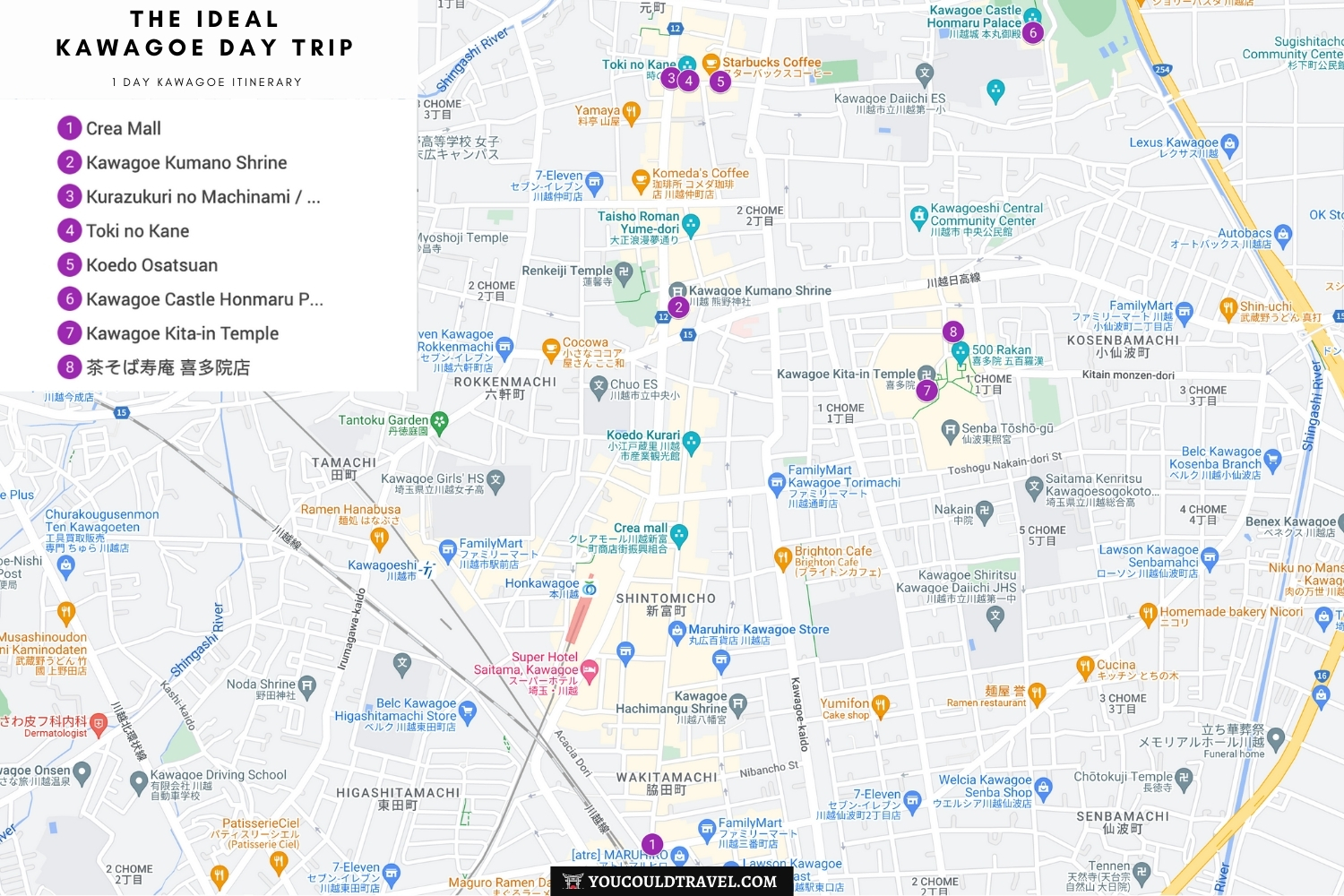
I created a dynamic Google Map with all points of interest in this Kawagoe itinerary.
I managed to do and see everything within one single day. I do want to mention that I visited on a public holiday (on Culture Day) so Kawagoe was absolutely packed, especially along Kurazukuri no Machinami. Some traditional soba restaurants had 90 minutes long queues (no, I didn’t wait, I got lots of street food instead!). Despite this small setback, and longer than usual queues, I still managed to see and do everything on my itinerary.
If you want to avoid crowds, I do recommend visiting on a weekday, and avoiding public holidays. However, it’s worth noting that during holiday periods you’ll get extra food and beverage stalls, making it extra fun to enjoy Kawagoe.
My day itinerary to Kawagoe involves quite a bit of walking, so ideally you’d visit on a clear day and wear comfortable shoes.
My final advice is to bring lots of cash with you. Almost every store, street food stall and even the soba restaurants I went to for dinner accepted cash only.
How to get to Kawagoe from Tokyo
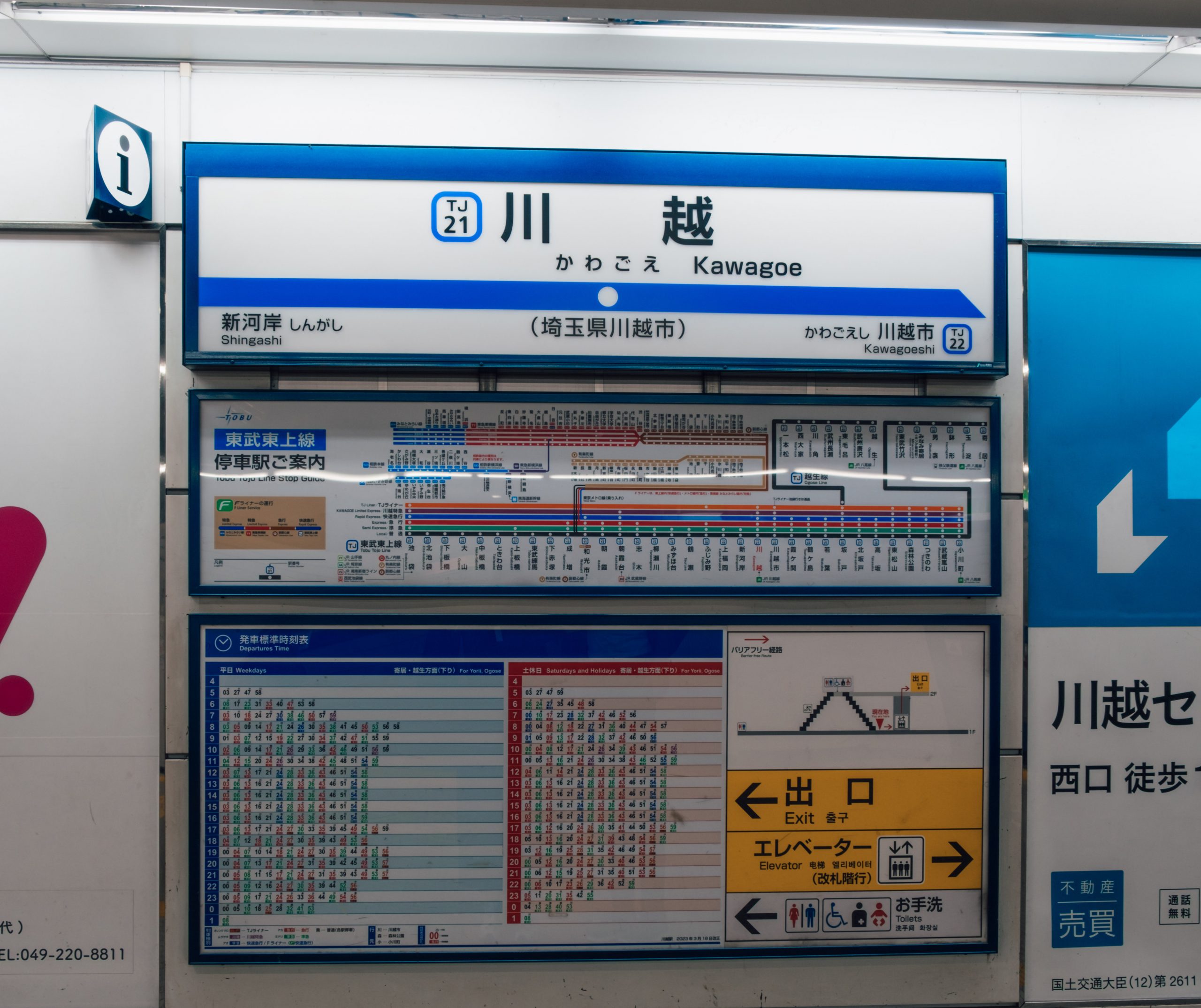
The fastest and easiest way to get to Kawagoe from Tokyo depends on where you are staying in Tokyo.
If you are closer to Shibuya and Shinjuku: Take the Yamanote Line to Ikebukuro. Then, switch to the Tobu-Tojo Line for Kawagoe Station. The fare is about ¥670 one way. Since I live near the Yamanote Line, this is my preferred route.
From Tokyo Station: Start with the Marunouchi or Yamanote Line to Ikebukuro. Then transfer to the Tobu-Tojo Line to reach Kawagoe Station.
Good to know: For a quicker journey, opt for the semi-express or limited express trains on the Tobu-Tojo Line, as they stop only at major stations.
The total travel time is roughly 45 minutes. Note that the Tobu-Tojo Line is not covered by a JR Pass.
Walk along Crea mall
Crea Mall is a pedestrian street near Kawagoe Station, lined with street food, restaurants, and souvenir shops. To find it, exit Kawagoe Station from the north and look for the large banner in English and Japanese marking the entrance. It’s a typical Japanese shopping street where time flies as you wander from one interesting shop to another.
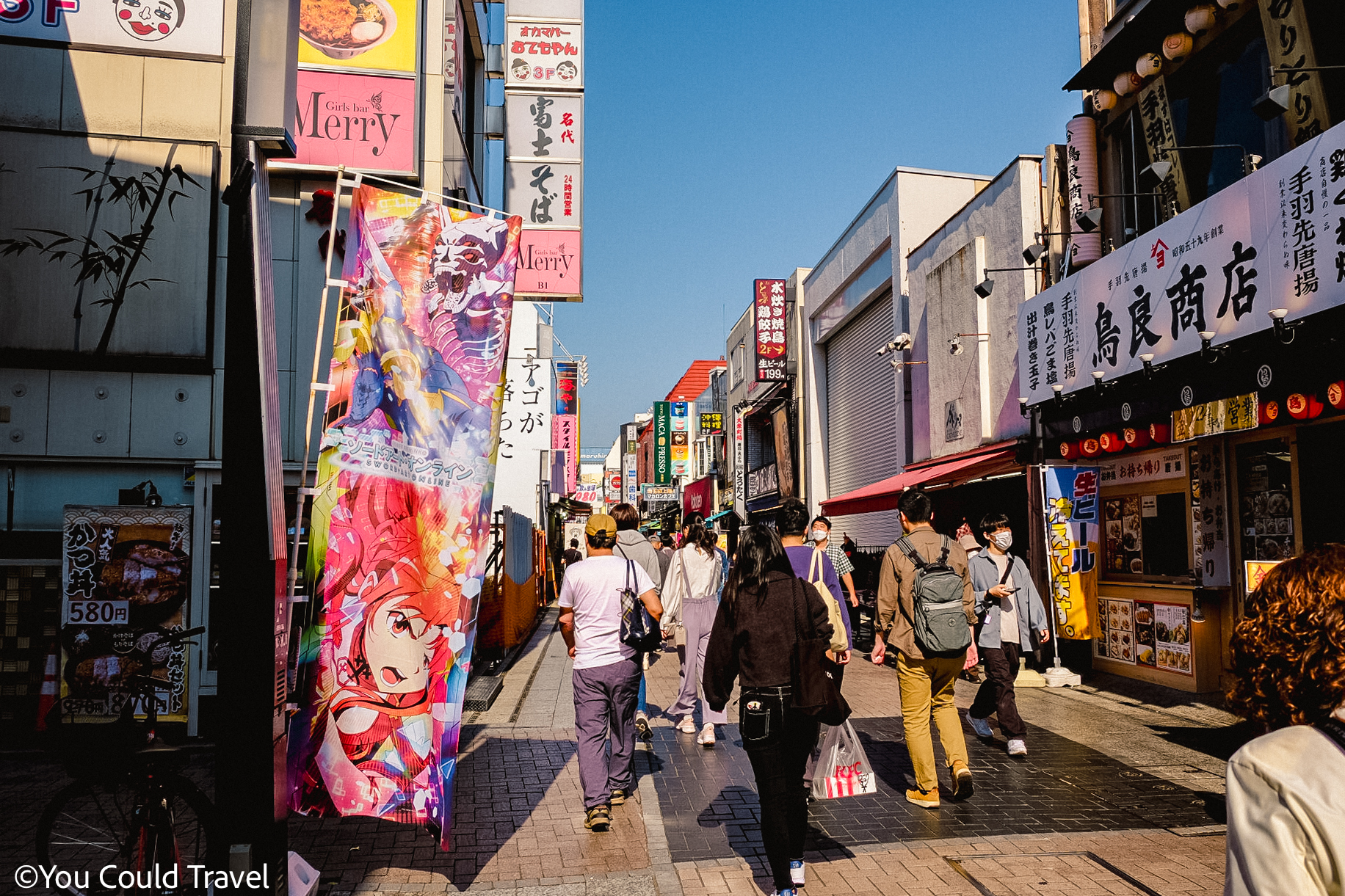
The shops open around 10am, so there’s no need to rush there early. Here, you can stumble upon charming pottery shops boasting exquisite ceramics, even featuring whimsical garden figures inspired by traditional Japanese folklore (e.g. Tenuki).
I, personally, found a beautifully crafted Inari mask here, at a surprisingly good price. A shop I particularly like is Osawa Pottery Shop, well-known for its selection of cups, bowls, and plates. And the best part? They pack your purchases really well, ensuring everything makes it back home with you in perfect condition.
Make a wish at Kawagoe Kumano Shrine
Entrance Fee: Free
Opening Yimes: 9:30 am–5 pm (weekdays); 9 am–5 pm (weekends)
Kawagoe Kumano Shrine, established in 1590, is revered for bringing good luck, aiding in marriage, and protecting against evil spirits. It’s dedicated to the Kumano deities (group of revered gods in the Shinto religion). You’ll notice the shrine’s emblem features a bird, the Yatagarasu, a symbol of guidance in Shinto belief. According to legend, Yatagarasu, a divine crow, guided Emperor Jinmu out of the mountains of Kumano to the Kashihara Shrine in Nara.
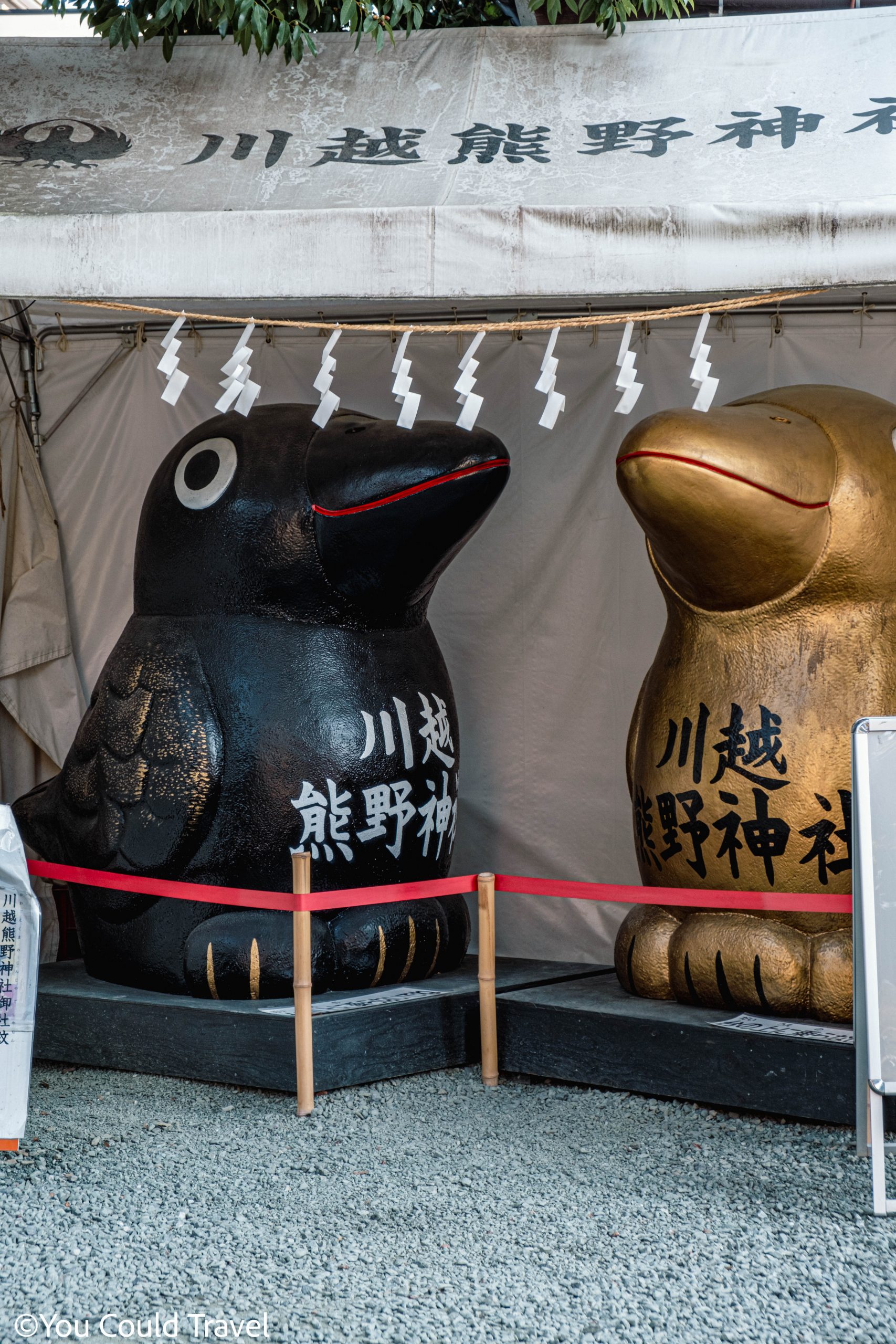
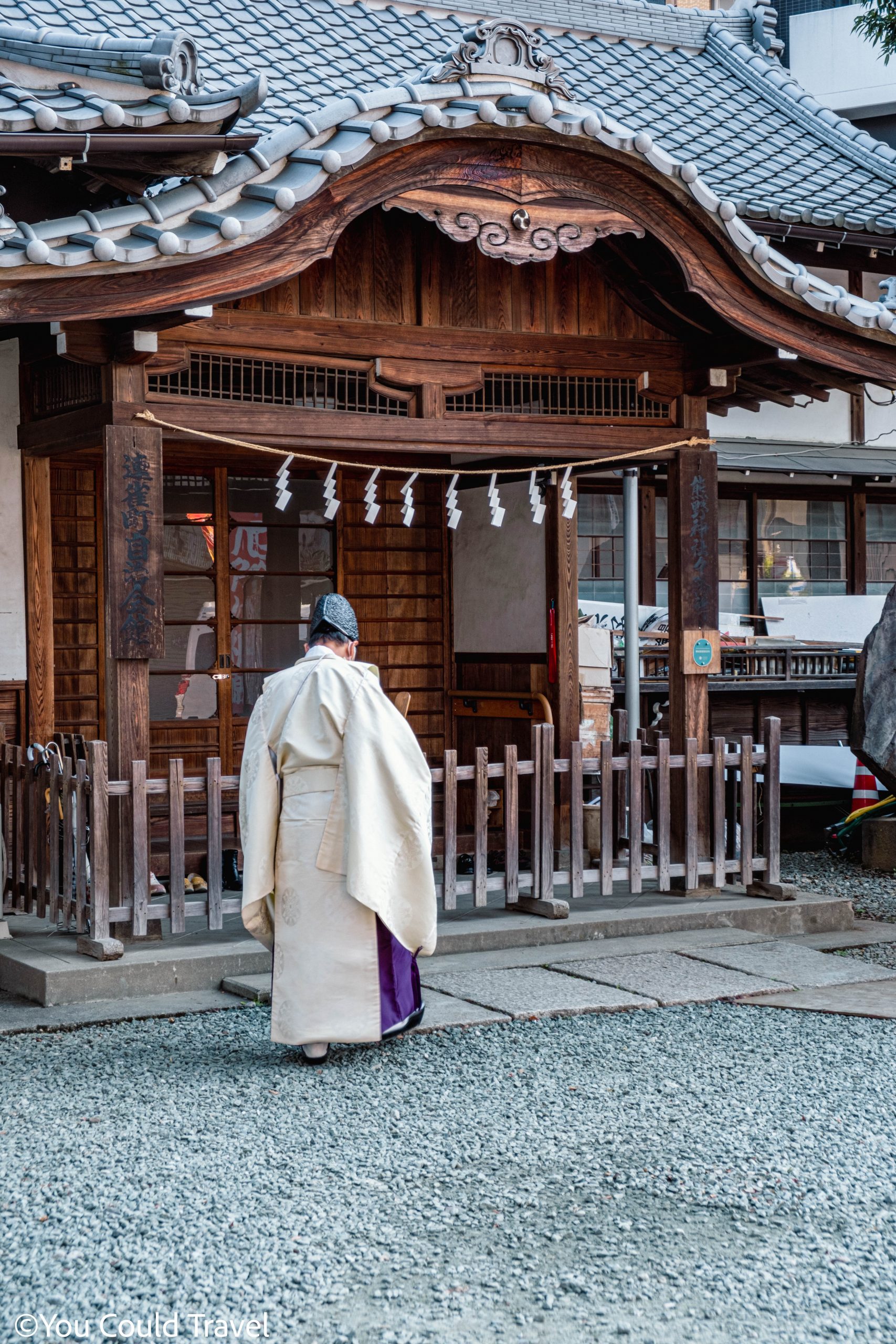
During my visit, I picked up an Omamori, a traditional Japanese amulet believed to offer luck and protection. These amulets, ranging from 500 to 800 yen based on size and design, are available for various purposes like health, safety, relationships, or economic fortune.
Visit Kurazukuri no Machinamino
Following Crea Mall’s lively shopping street will naturally lead you towards Kurazukuri no Machinami. It’s impossible to miss – you’ll instantly know when you’ve arrived. Also known as Warehouse Street, it’s celebrated for its traditional kurazukuri-style buildings, unique to the Edo period.
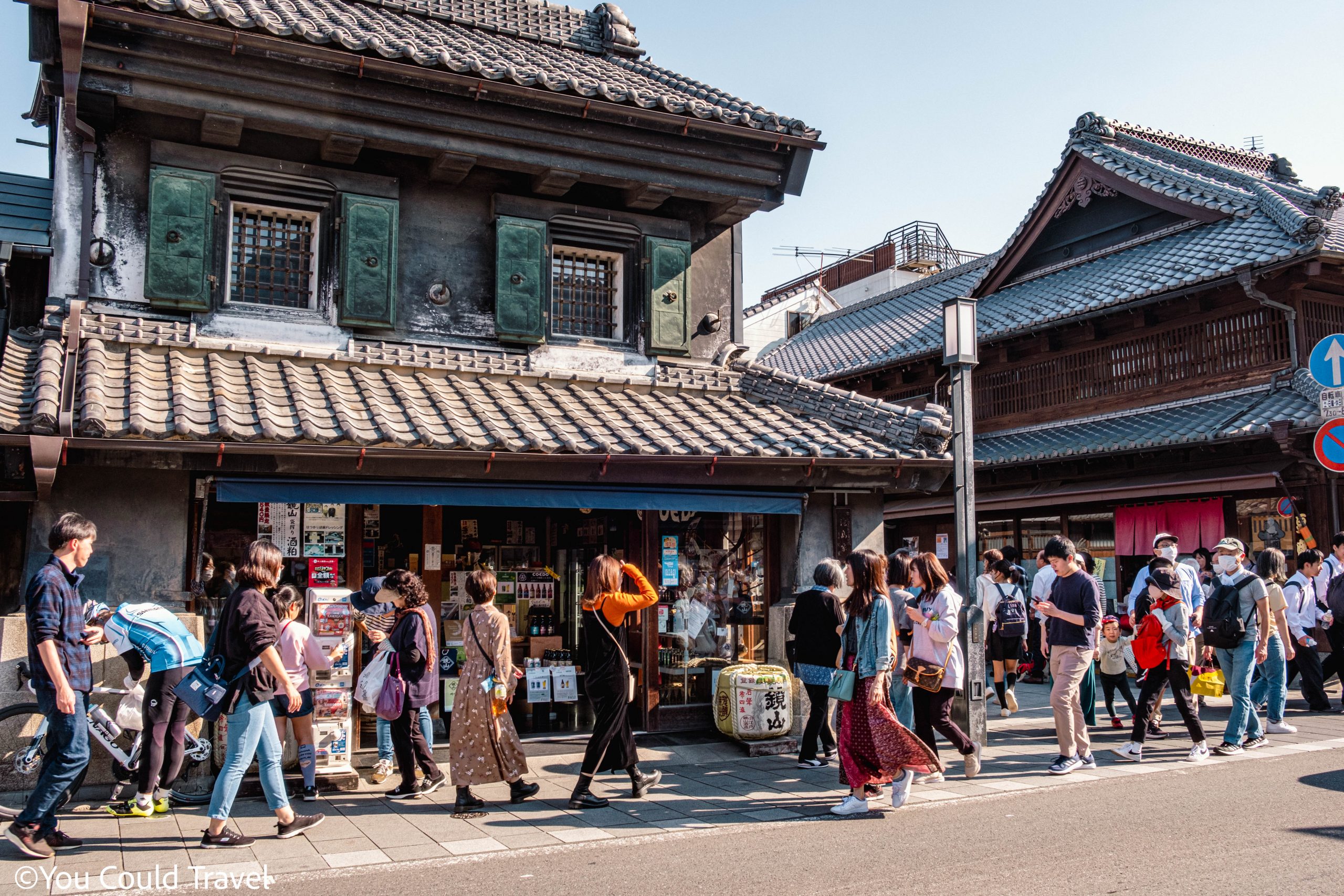
These buildings, famous for their thick, fireproof walls made from a mixture of clay, wood, and other materials, were designed to withstand the frequent fires in Japanese wooden towns. The walls, coated in black or dark gray plaster, give a distinctive look unlike any other Edo-style towns in Japan.
Now, many of these historical buildings have been transformed into shops and restaurants. It’s a fantastic spot to try a variety of street food. During my visit on Culture Day, the area was buzzing with vendors, including old-fashioned sweet potato roasters and local elders selling cucumbers on sticks (yes, really!).
See the Toki no Kane (Bell Tower)
Toki no Kane, often called the Bell of Time, stands as the historic emblem of Kawagoe. Originating from the 17th century in the Edo Period, its purpose was exactly as its name suggests – to keep time.
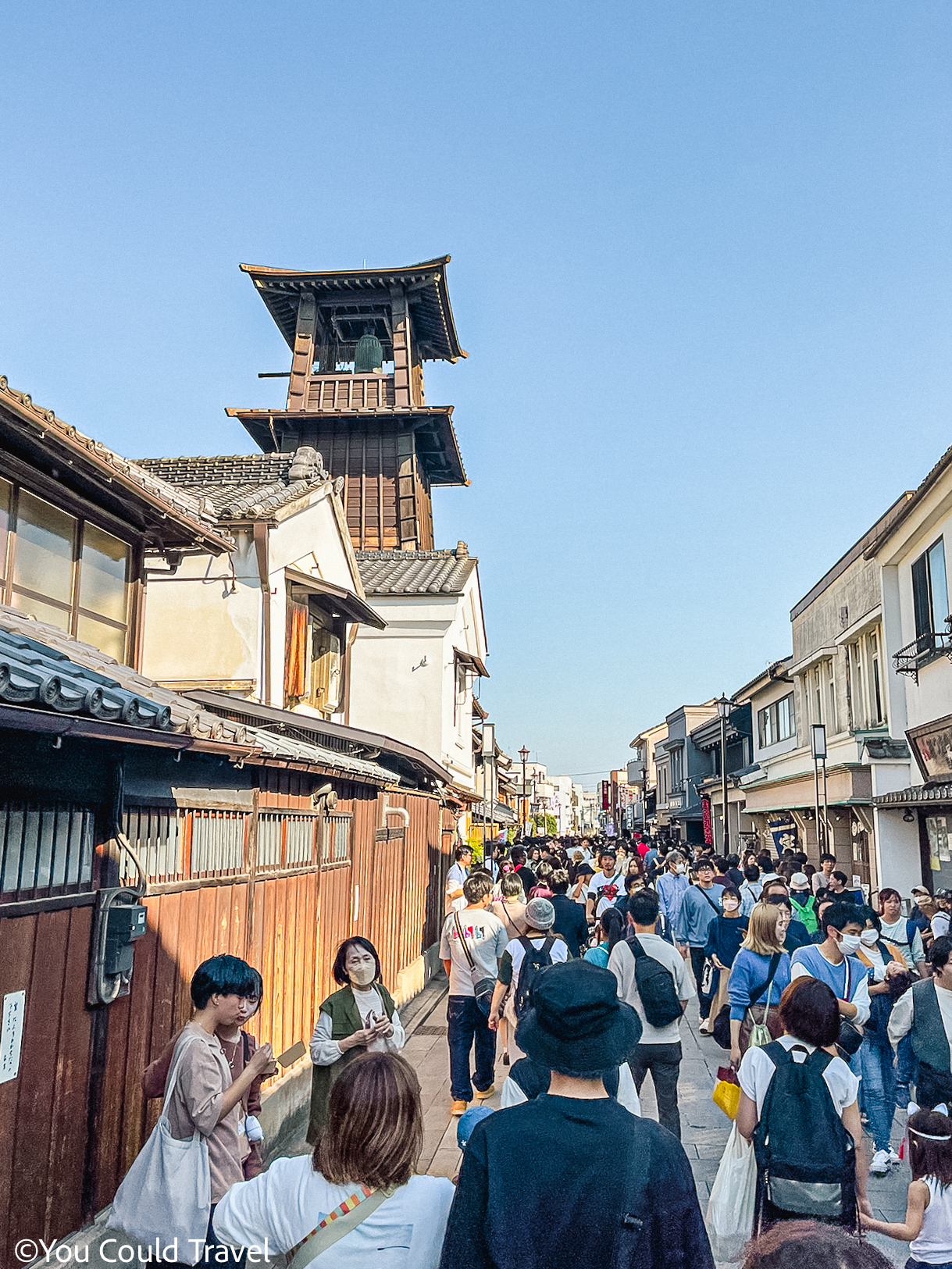
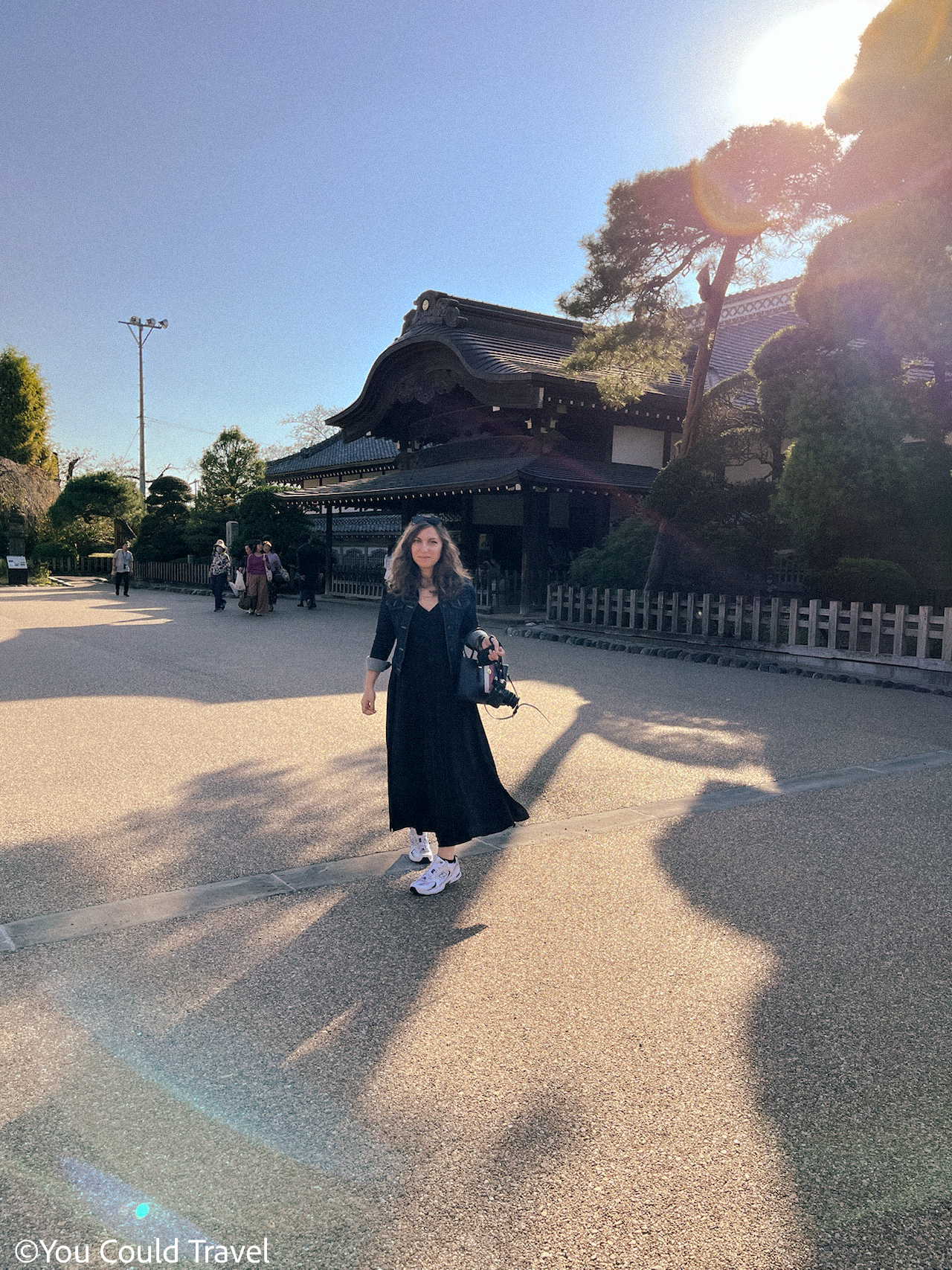
The tower reaches about 16 meters in height and is built in a traditional Japanese architectural style, primarily using wood. Due to its wooden construction, the tower has undergone several reconstructions, with the present structure dating back to 1893.
Continuing its age-old tradition, the bell still rings four times daily (at 6 AM, 12 PM, 3 PM, and 6 PM), marking the hours for Kawagoe’s residents.
Enjoy Street food for lunch
No trip to Kawagoe is complete without getting your sweet potato fix from Koedo Osatsuan. They offer freshly made sweet potato chips with various sauces. My personal favorite was the salt butter sauce, while my husband preferred the black honey cream. On weekends and public holidays, the queues are very long but they go very fast so it’s still worth waiting in line.
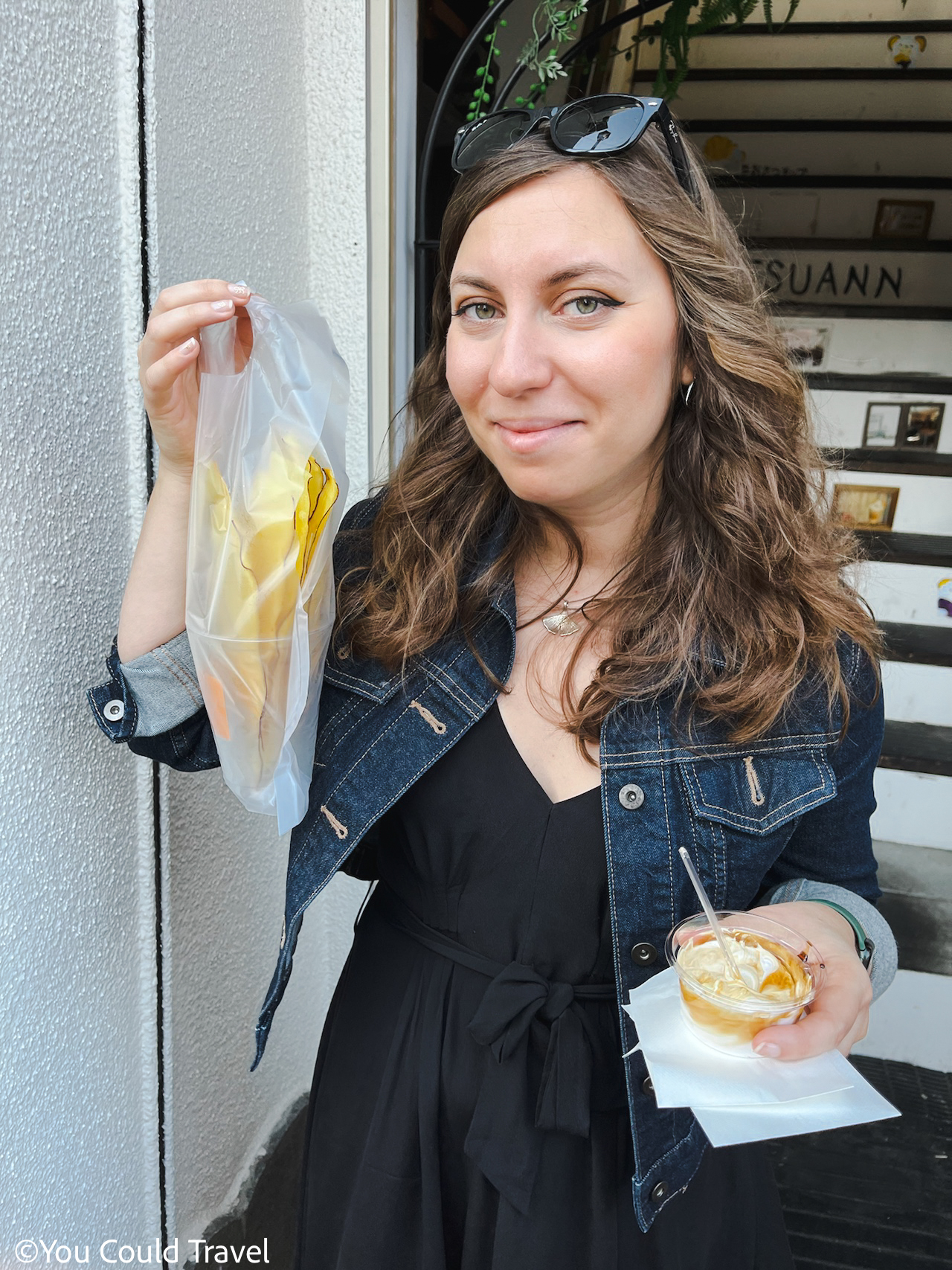
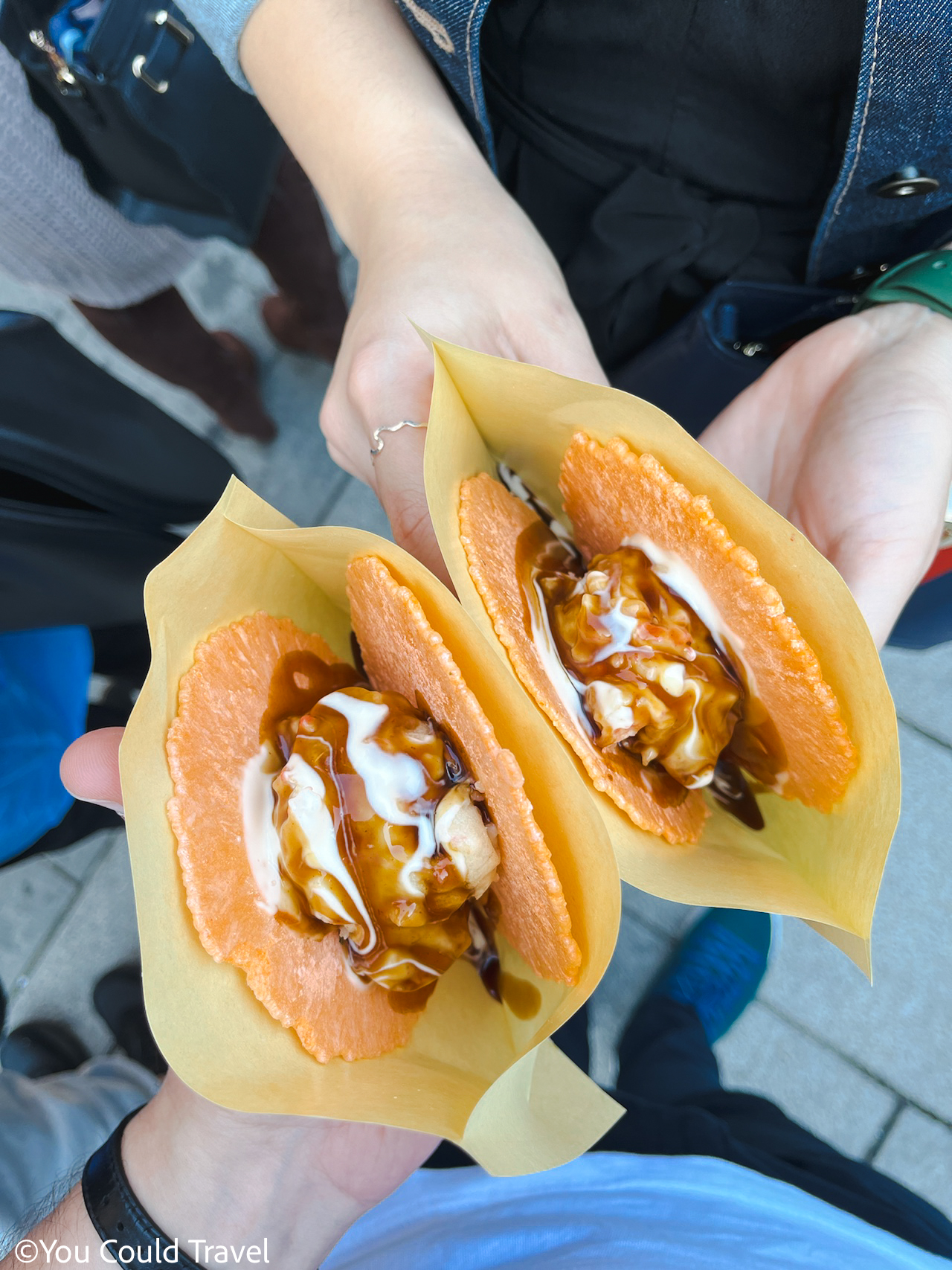
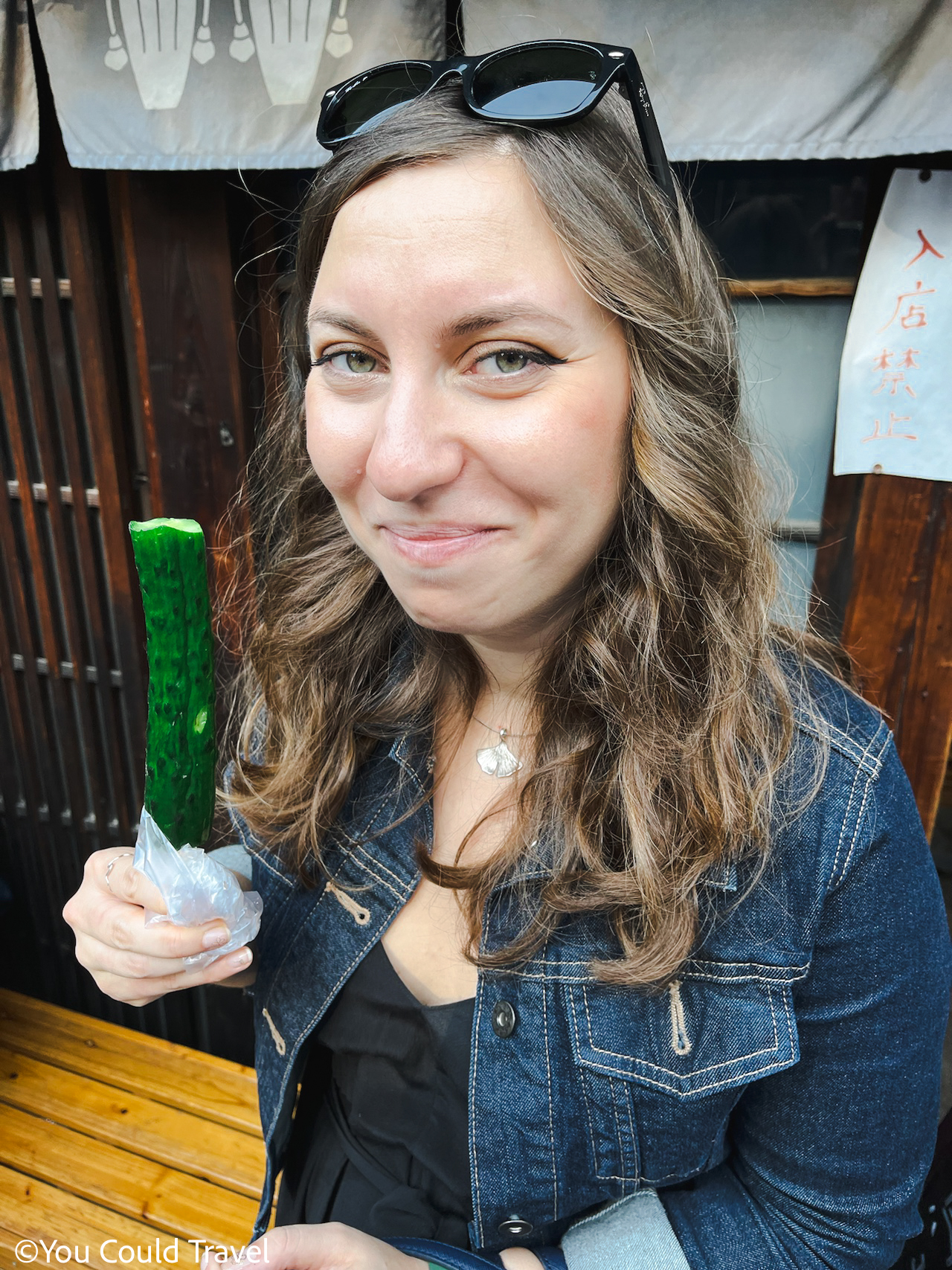
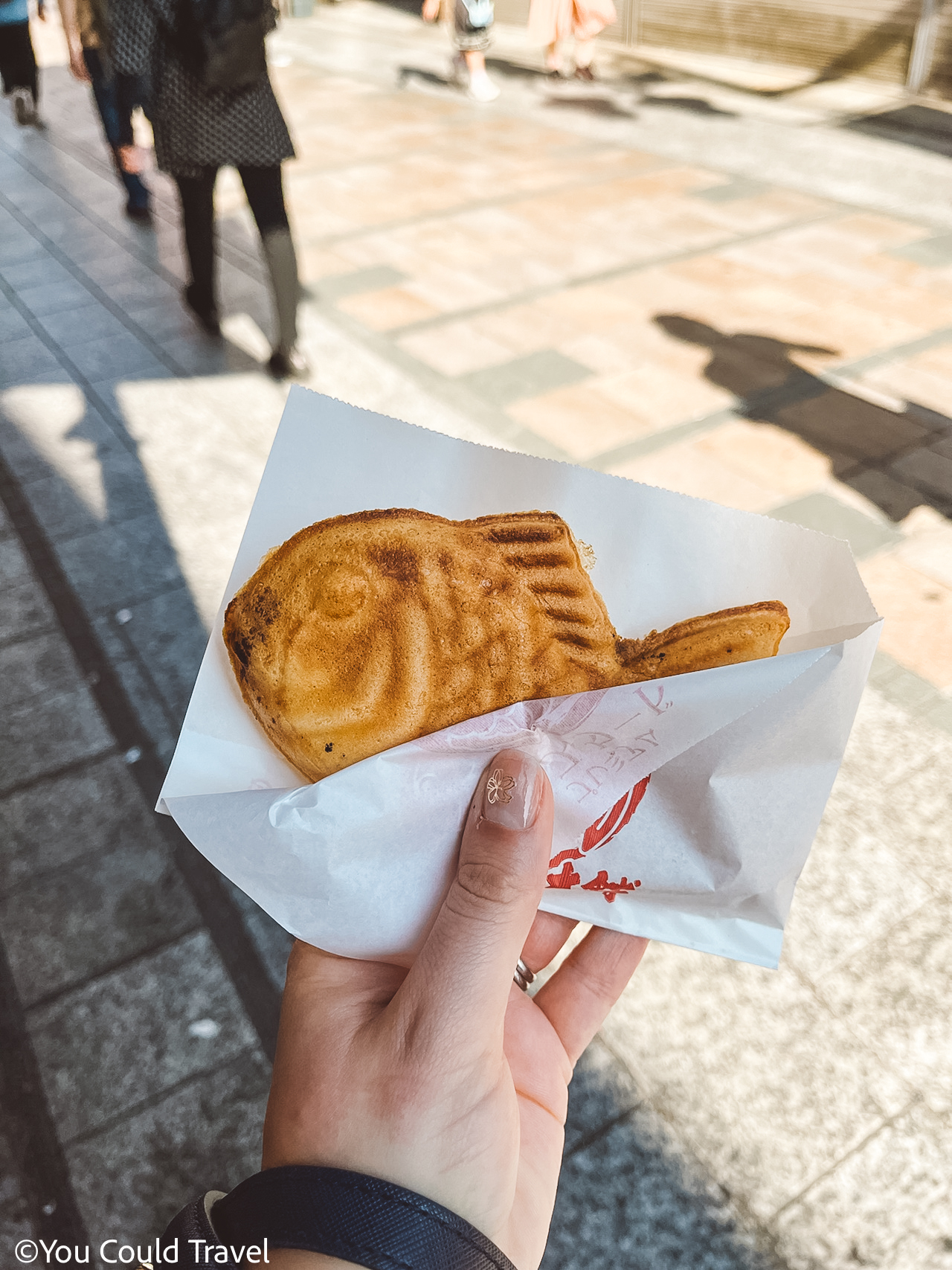
On the sunny day I was there, I tried a Japanese cucumber, served cold and crunchy on a stick. It was extremely refreshing, especially because the cucumbers are kept in salty iced water – a clever and tasty idea.
I also highly recommend trying takosen from Kanon. This inventive snack is takoyaki sandwiched between rice crackers, and it’s incredibly good.
Of course, you should try taiyaki, the classic Japanese fish-shaped cake. It’s filled with sweet azuki bean, custard, matcha, or chocolate.
These are my experiences and recommendations, but there’s plenty more to discover in Kawagoe’s vibrant street food scene. You’ll find dango, kushiage (skewered fried meats and vegetables), and everything matcha. If you’re into sweets, there are many stalls selling candied fruits, usually strawberries and muscat grapes.
Buy Retro Sweets from Candy Alley (Kashiya Yokocho)
Opening Times: 10 am–5 pm
Kashiya Yokocho is located just 5 minute walk from Kurazukuri no Machinamino. Kashiya Yokocho also Candy Alley is a narrow alleyway lined with small Japanese shops selling nostalgic sweets and snacks. This is the perfect place to buy Japanese candies that have been made exactly the same for generations.
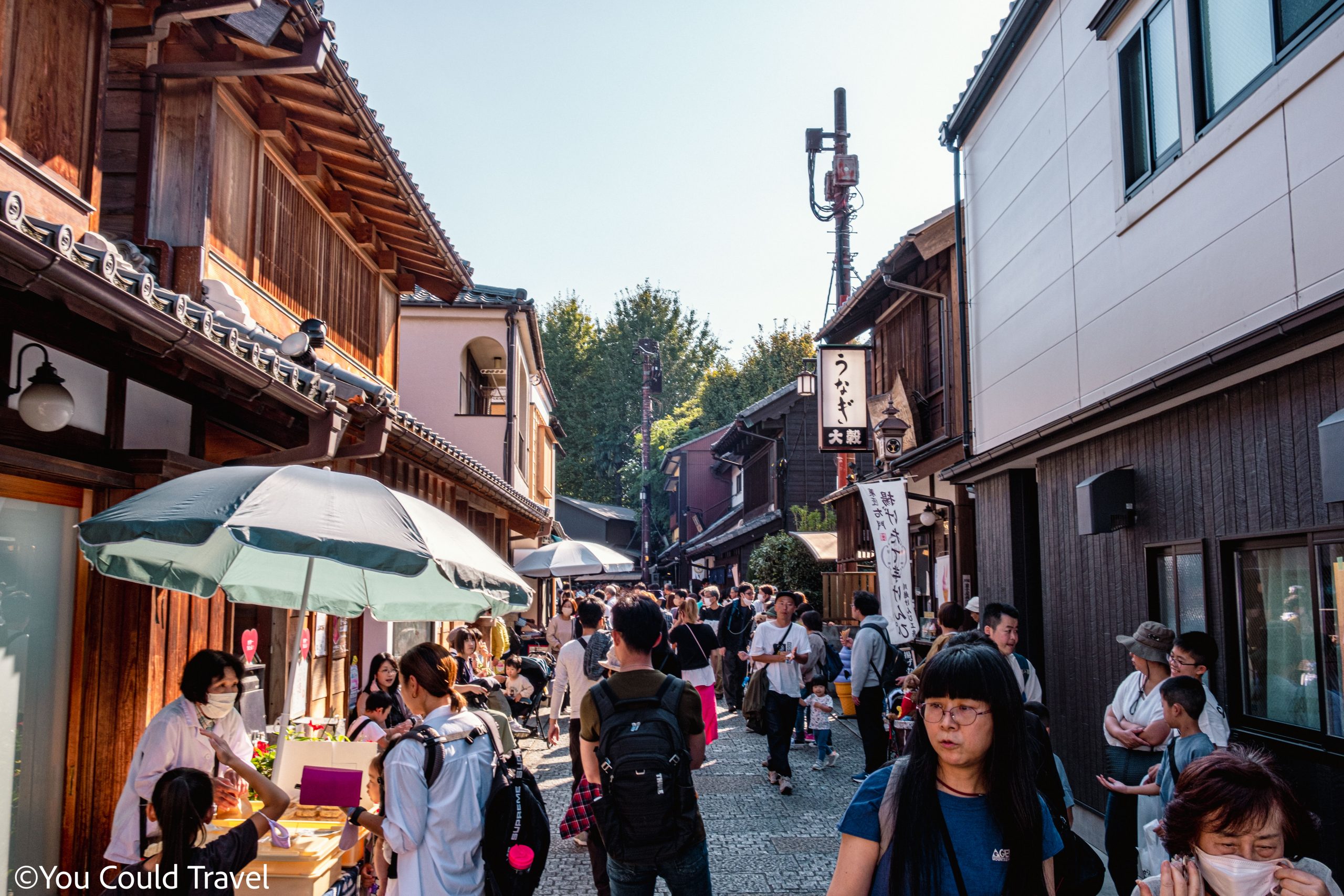
This lovely candy alley has a Showa Era feel to it as it dates back to the early 20th century, and it survived a great fire in 1893 which means that many of the shops are still very historic.
The most nostalgic traditional sweets you can buy here is the Kawagoe Fugashi which is a Japanese candy made of dried wheat gluten coated with Okinawan brown sugar. These particular Fugashi are special because their packaging depicts the Kawagoe Bell Tower. For something even sweeter get imonatto (sweet potatoes boiled with syrup), and the imokempi (sweet potatoes dusted with sugar). I’m sure you can tell by now that sweet potato is a big deal in Kawagoe!
Visit the Kawagoe Castle Honmaru Palace
Entrance Fee: 100 yen
Opening Times: 9 am–5 pm; Mondays closed
Kawagoe Castle Honmaru Palace is a 15th century Japanese castle built by the vassals Michizane Ota and Dokan Ota on the orders of Mochitomo Uesugi. The castle was a strategic base for the Tokugawa shogunate. Kawagoe Castle Honmaru Palace was known as the Gateway to the North and used to control the northern approach to Edo (now Tokyo).
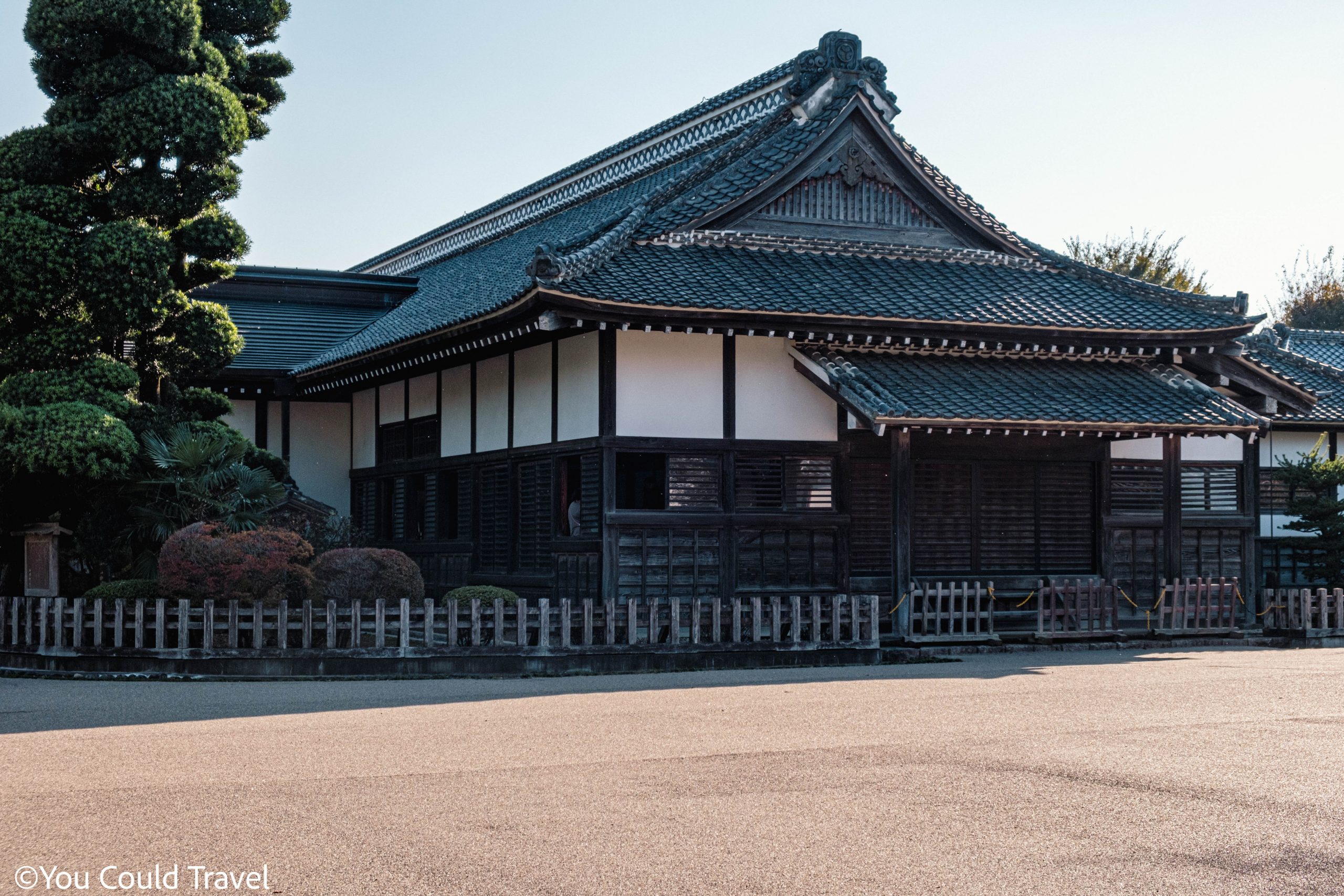
The castle served as the residence for the feudal lords (daimyo) who governed Kawagoe. Today, you can visit the Honmaru Palace which was last reconstructed in 1848. The interior shows you how feudal lords used to live, and you can learn about the lifestyle of the samurai class.
Admire the Kawagoe Kita-in Temple
Entrance Fee: Free
Opening Times: 9 am–4 pm
Kita-in Temple, established in 830, was a favorite of the Tokugawa family. Its most captivating feature is the 500 Rakan statues, representing Buddha’s disciples, each with a unique facial expression and pose.
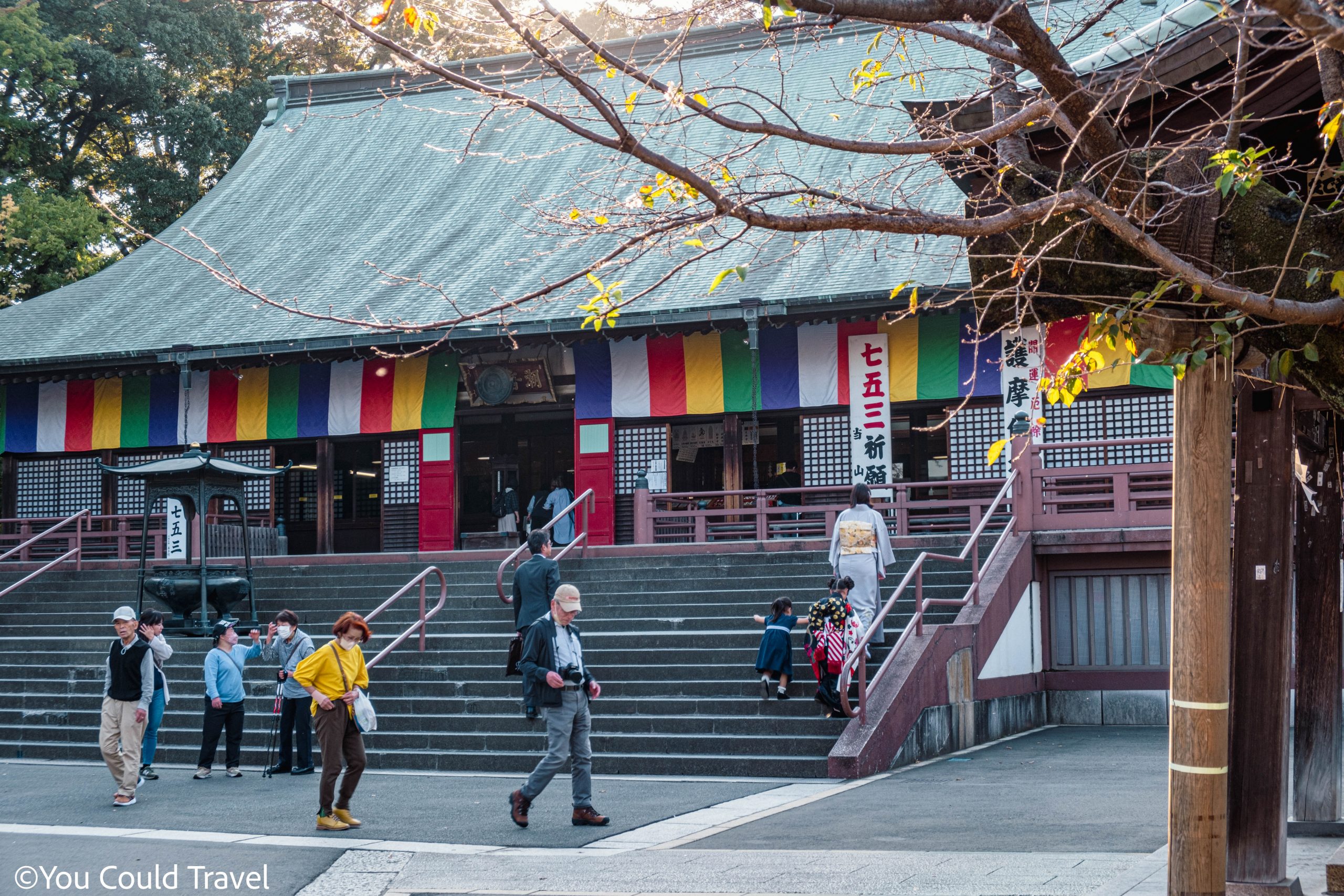
These statues, carved in the early 19th century, are scattered across the temple grounds. A personal highlight for me is the Tahoto Pagoda, standing 13 meters tall with its distinctive square, three-tiered roof.
During my visit, I experienced the Koedo Kawagoe Chrysanthemum Festival (Kiku Matsuri), held annually from November 1st to 23rd. The festival takes place in the main courtyard, right near the pagoda and the 500 Rakan statues. There’s no entrance fee to view the Chrysanthemum displays at the temple.
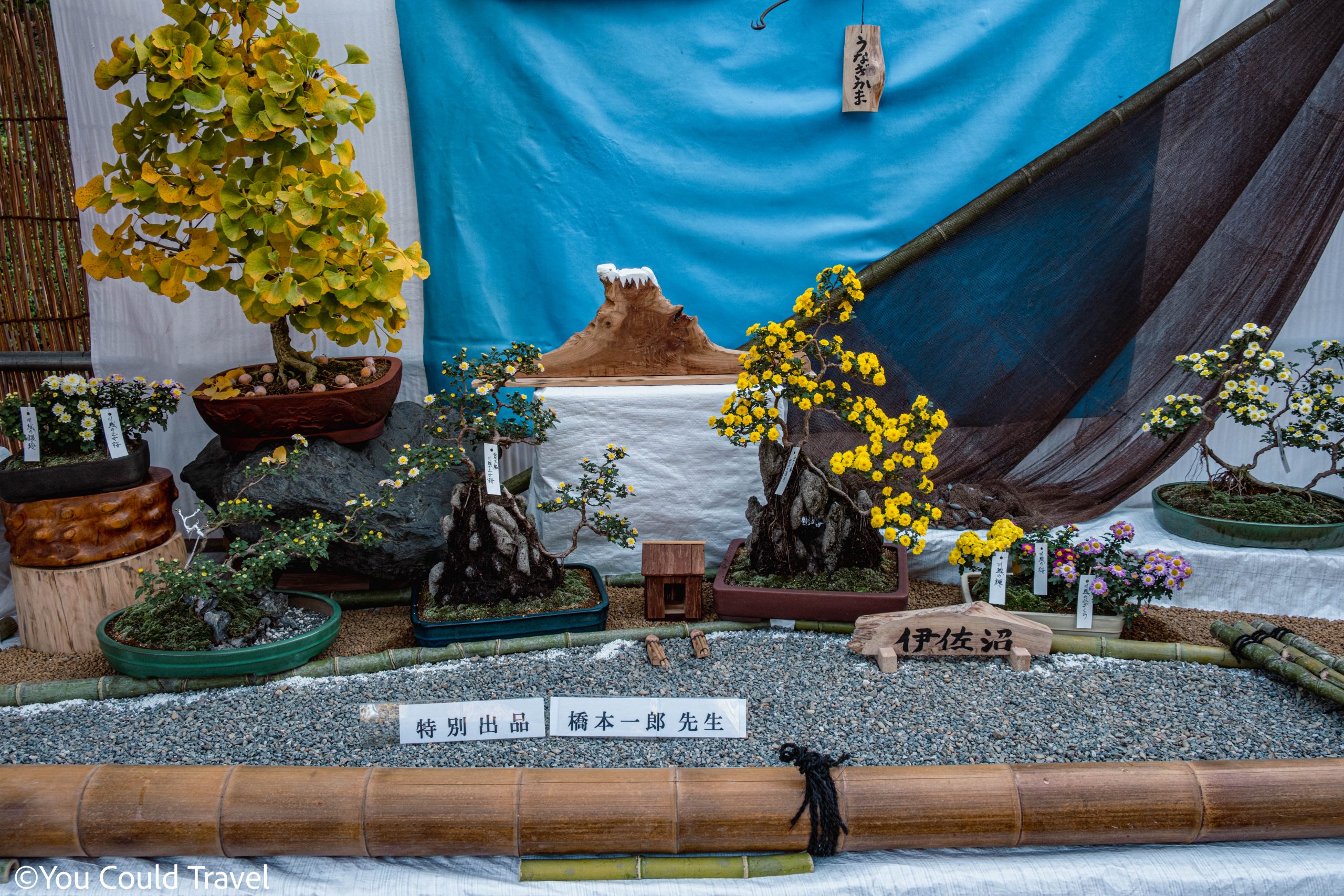
Have matcha soba at Kotobuki-an Kitain
By now, you might be feeling a bit peckish after all the exploring. Right in front of Kita-in Temple there is a traditional Japanese soba place which specialised in cha soba (green tea soba). It’s called Kotobuki-an Kitain.
I recommend the matcha soba and small tempura bowl set which comes with salad and soup. The soba is made with Japanese buckwheat flour and high-quality matcha from Koyamaen in Uji, Kyoto.
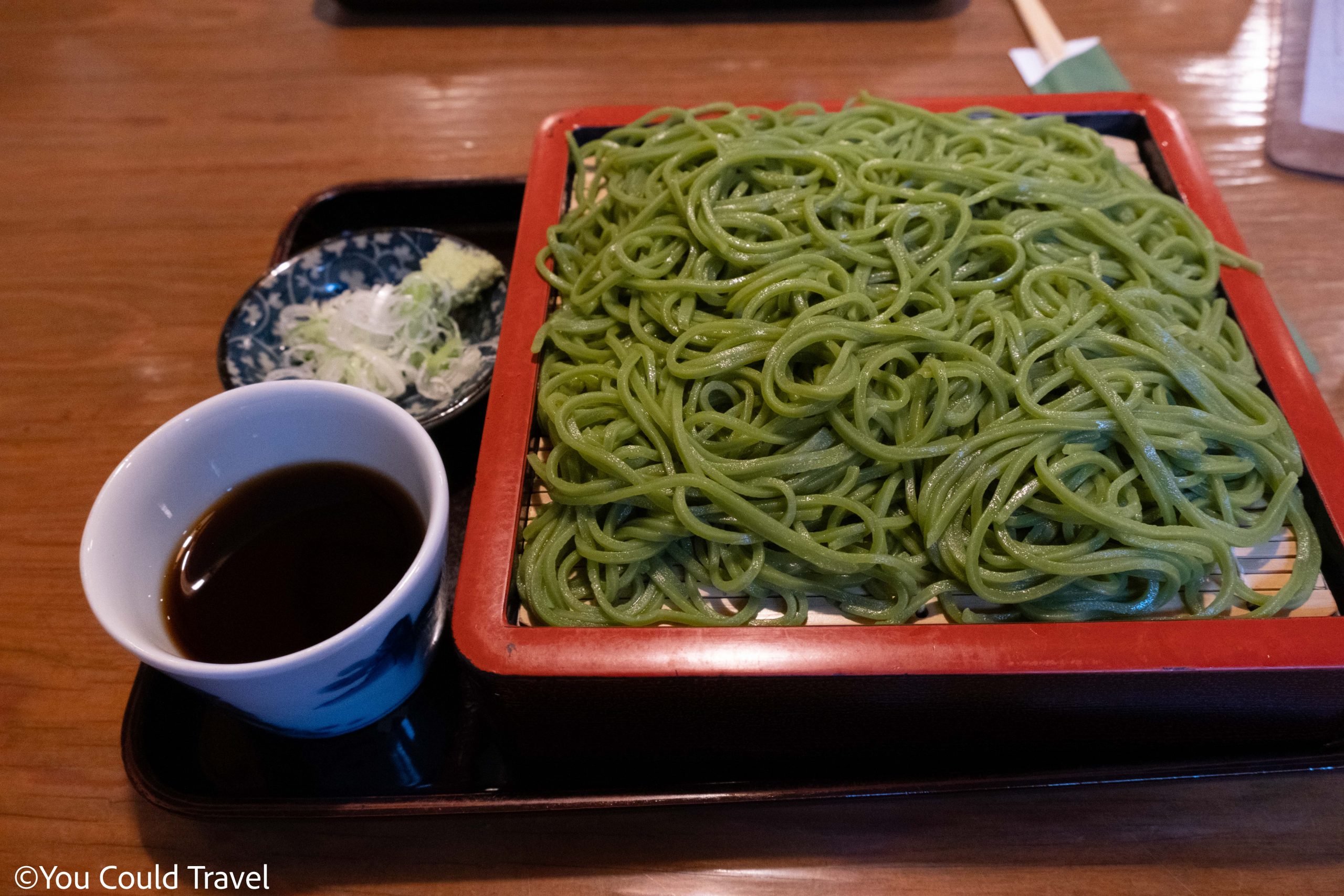
Please bear in mind that the restaurant closes at 4pm and that is takes cash only.
If it’s after 4pm and you’re looking for a great dinner place, I can recommend a local favourite: Shinra Garden Yahatadori which is a yakiniku (grilled meat) restaurant. It’s a multi course dinner with many small dishes and high quality A5 rank Japanese beef. Some dinner course come with all you can drink options too. Reservations are a must.
Optional: Walking tour with a traditional kimono
For a truly unique and fun experience in Kawagoe, consider renting a traditional Japanese kimono. It’s a fantastic way to dive into the culture. The staff at the kimono rental place are incredibly helpful – they’ll assist you in picking out a kimono that fits perfectly and matches your personal style with its colour and pattern. They’ll expertly dress you in the kimono, complete with a sash belt (obi), making sure everything looks just right.
You’ll also get to accessorize with a cute Japanese clutch. To top it off, you’ll wear traditional sandals and socks, which are surprisingly comfortable and add to the authenticity of the experience. I would know, I did wear a Japanese kimono before!
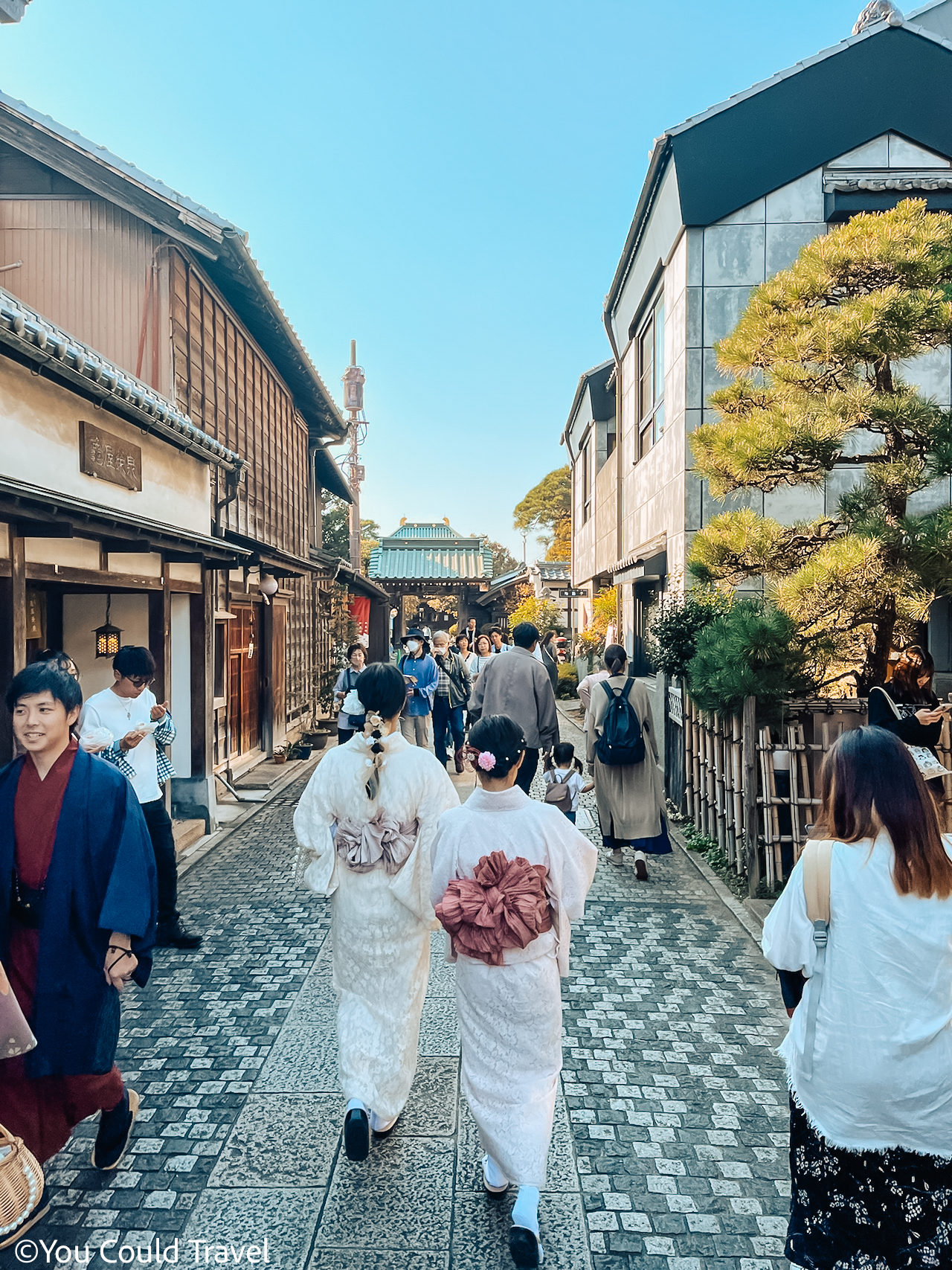
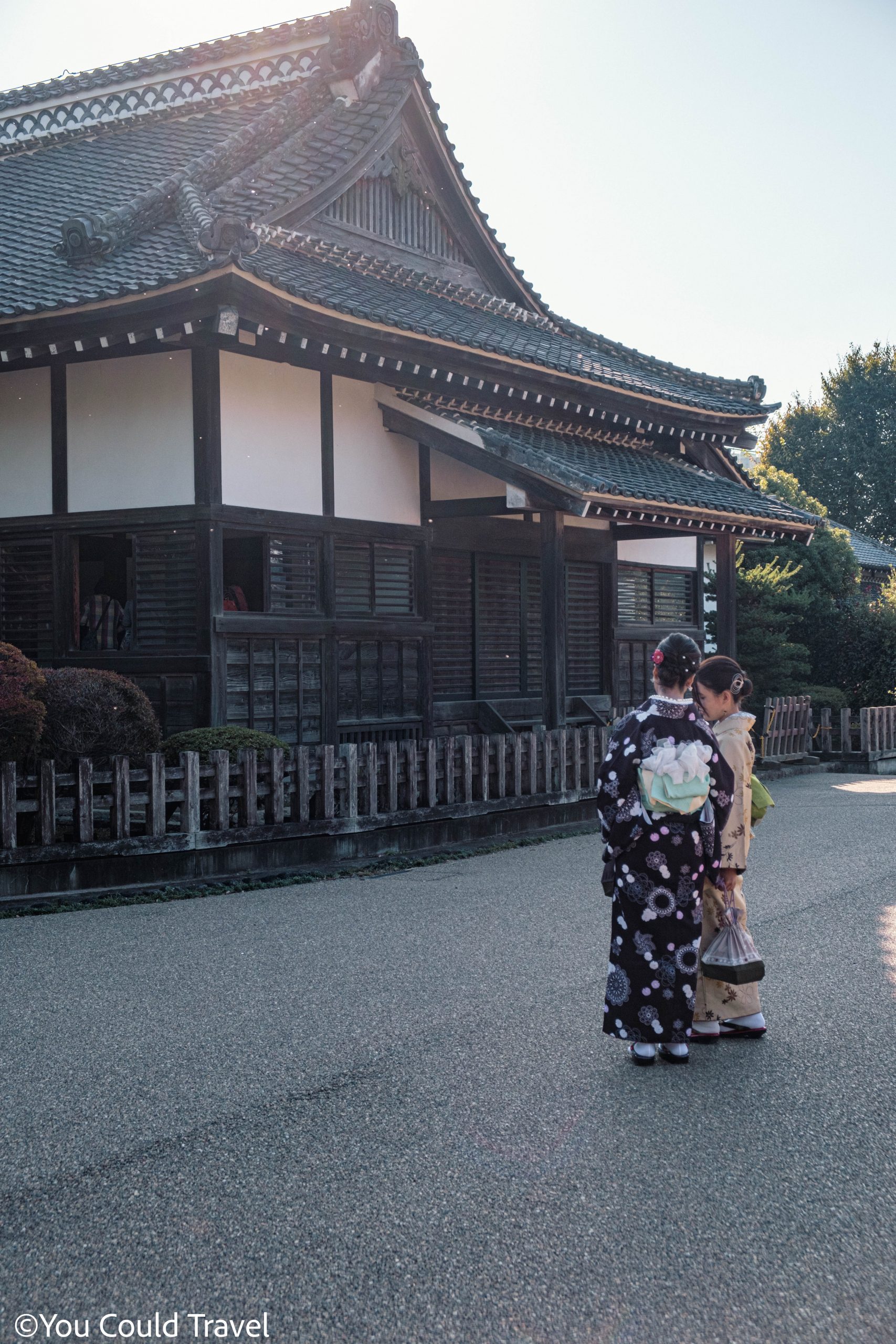
How to get back to Tokyo from Kawagoe
Returning to Tokyo from Kawagoe is straightforward with frequent and quick train services. Simply retrace your steps to Kawagoe Station and catch the Tobu-Tojo Line to Ikebukuro. From Ikebukuro, you can transfer to the Yamanote Line or the Marunouchi Line for various parts of Tokyo.
There’s no rush to head back, as the Tobu-Tojo Line runs until late in the evening. However, it’s important to leave Kawagoe by 23:00 to avoid missing the last subway connections to your accommodation in Tokyo.
Final Thoughts on my Day trip to Kawagoe
Kawagoe is an amazing destination to explore, especially considering its proximity to Tokyo – it’s less than an hour away for a day trip. Its historic charm and architecture are remarkable.
The traditional Japanese food here, particularly the street food, is fantastic. I wasn’t a big fan of sweet potatoes before moving to Japan, but now I absolutely love them. It might be the local preparation that makes the difference. The variety of sweet potato dishes in Kawagoe is impressive and was a highlight for me.
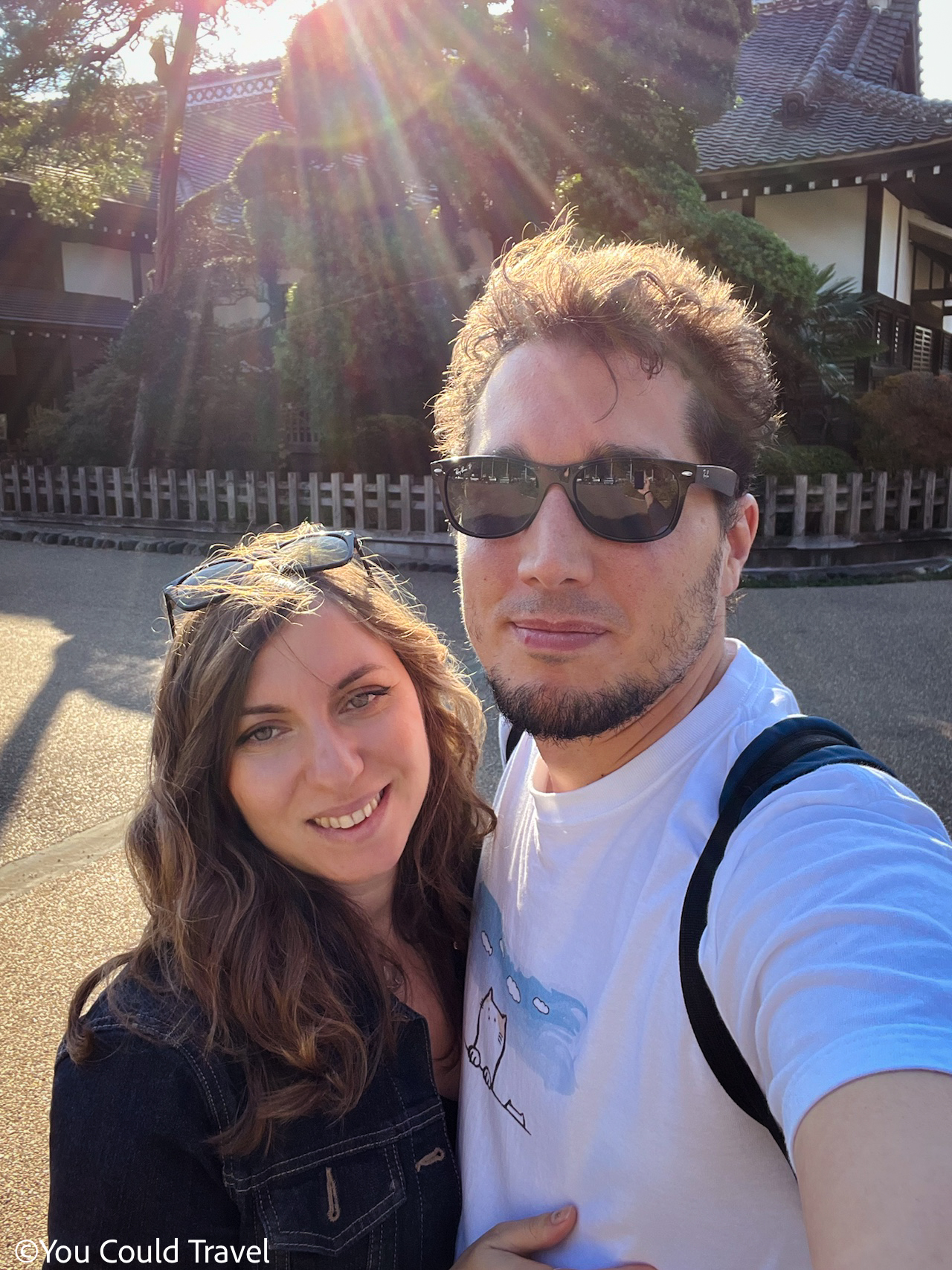
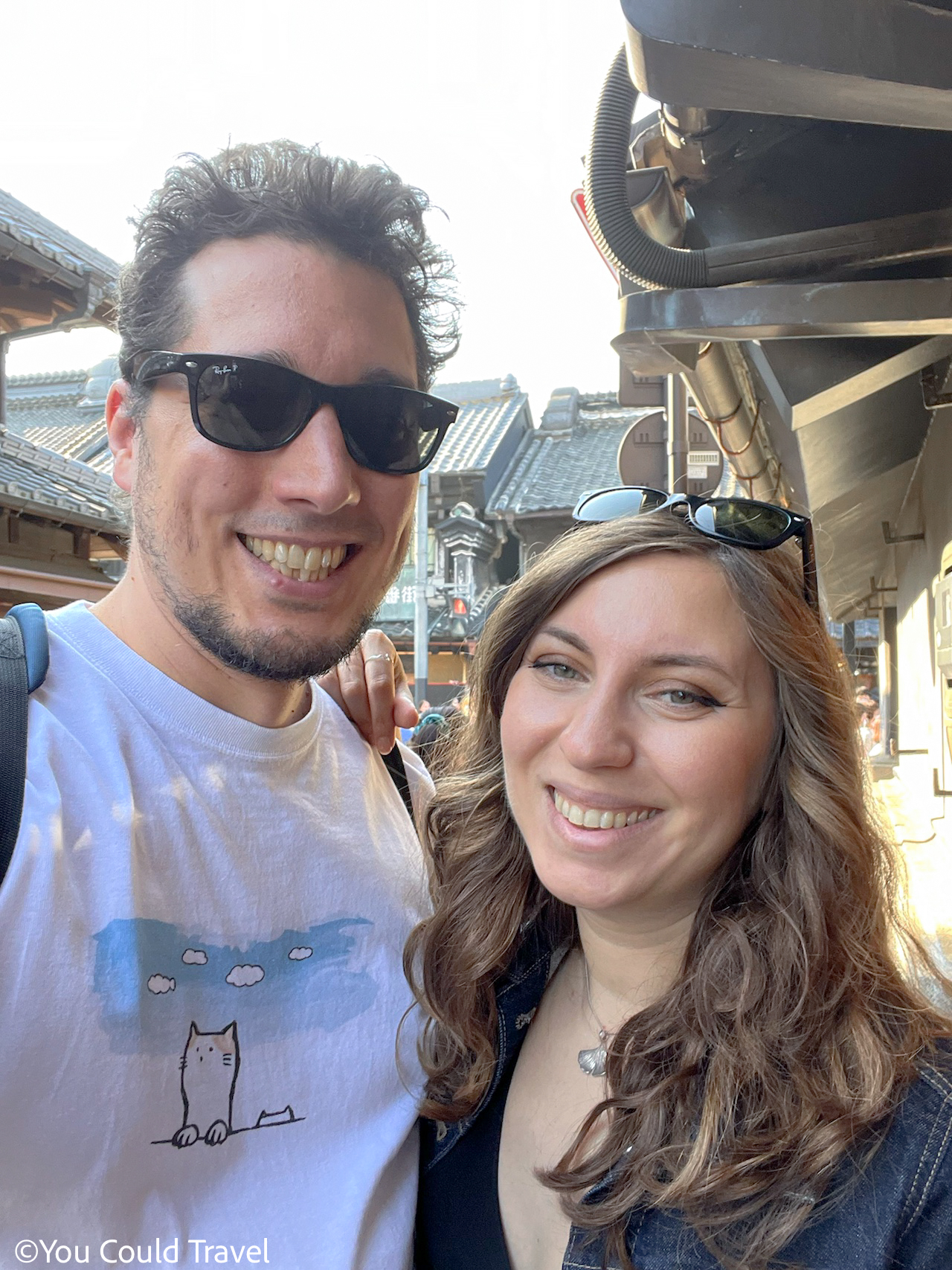
If you’re into quaint, charming cities with traditional architecture, delicious street food, and beautiful temples, Kawagoe is a must-visit. It’s a delightful blend of history and culture, perfect for adding to your travel list.
Want more day trips from Tokyo ideas? Make sure to visit Kamakura, Enoshima Island, Yokohama and Hakone.
Frequently Asked Questions
How much time do you need in Kawagoe?
One day is enough to see all the main attractions in Kawagoe including the warehouse district, the bell tower, a couple of temples and eat lots of street food. I arrived at around 10am in Kawagoe and by the evening I was finished with all the most important points of interest and headed back to Tokyo. Kawagoe is fantastic as a day trip from Tokyo as it’s easy to reach by train.
Is it worth it to go to Kawagoe?
Kawagoe is 100% worth visiting. It’s a beautiful small city just 45 minutes from Tokyo, full of history, wonderful Edo style architecture and great food. You wouldn’t want to miss it during your time in Japan. It’s perfect as a day trip as you will get to see all the main highlights and important points of attraction in one single day.
What is Kawagoe known for?
Kawagoe is often called Little Edo known for its well-preserved Edo-period buildings, particularly the kurazukuri (warehouse-style) buildings.
Toki no Kane (Bell of Time) is a symbol of Kawagoe, has been telling time to the city’s residents for centuries. Kawagoe is renowned for its sweet potatoes and offers a variety of sweet potato-based treats, including ice cream, snacks, and sweets. I do recommend the sweet potato chips especially!
Kashiya Yokocho is a charming street lined with traditional candy shops selling a variety of Japanese sweets and snacks.
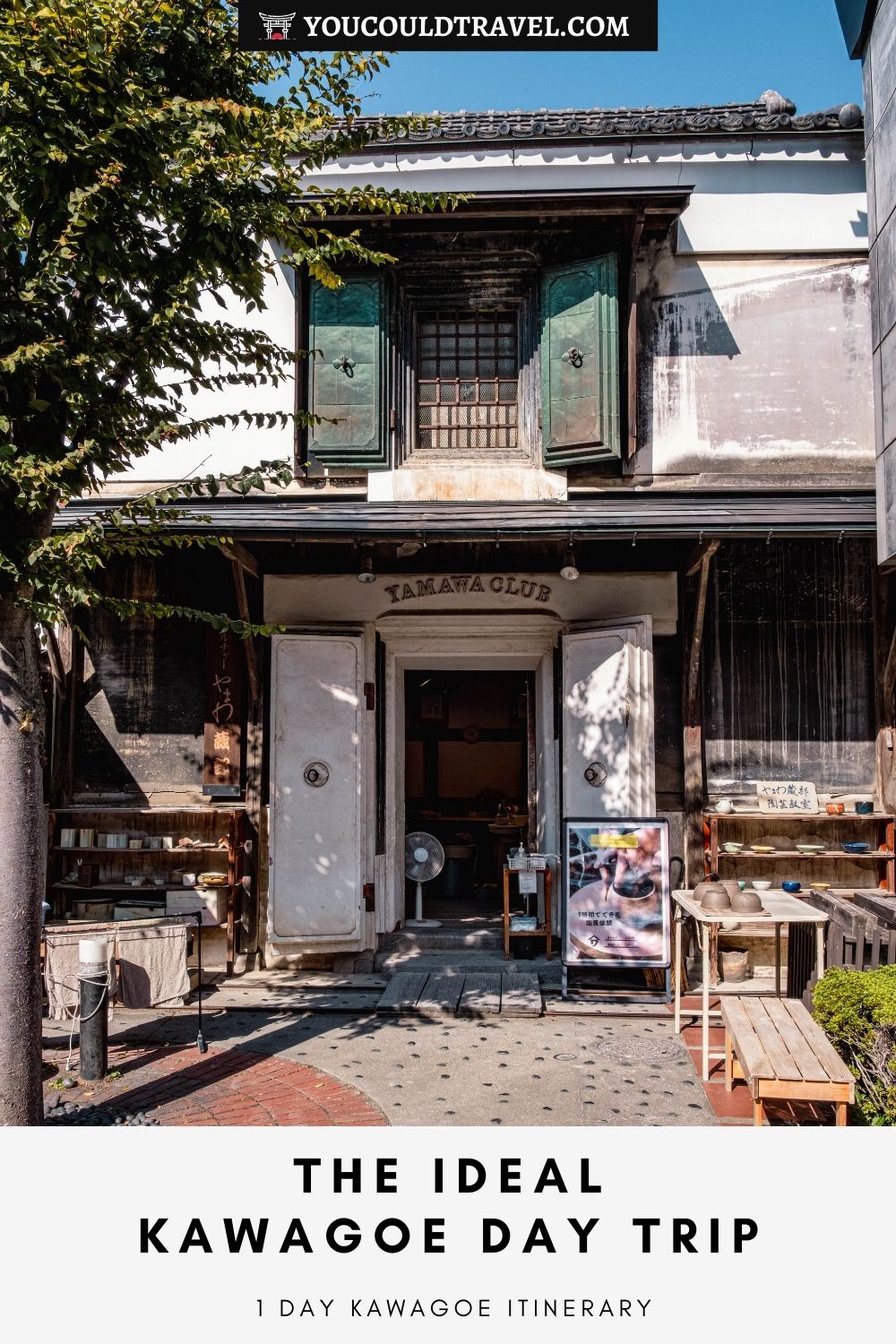
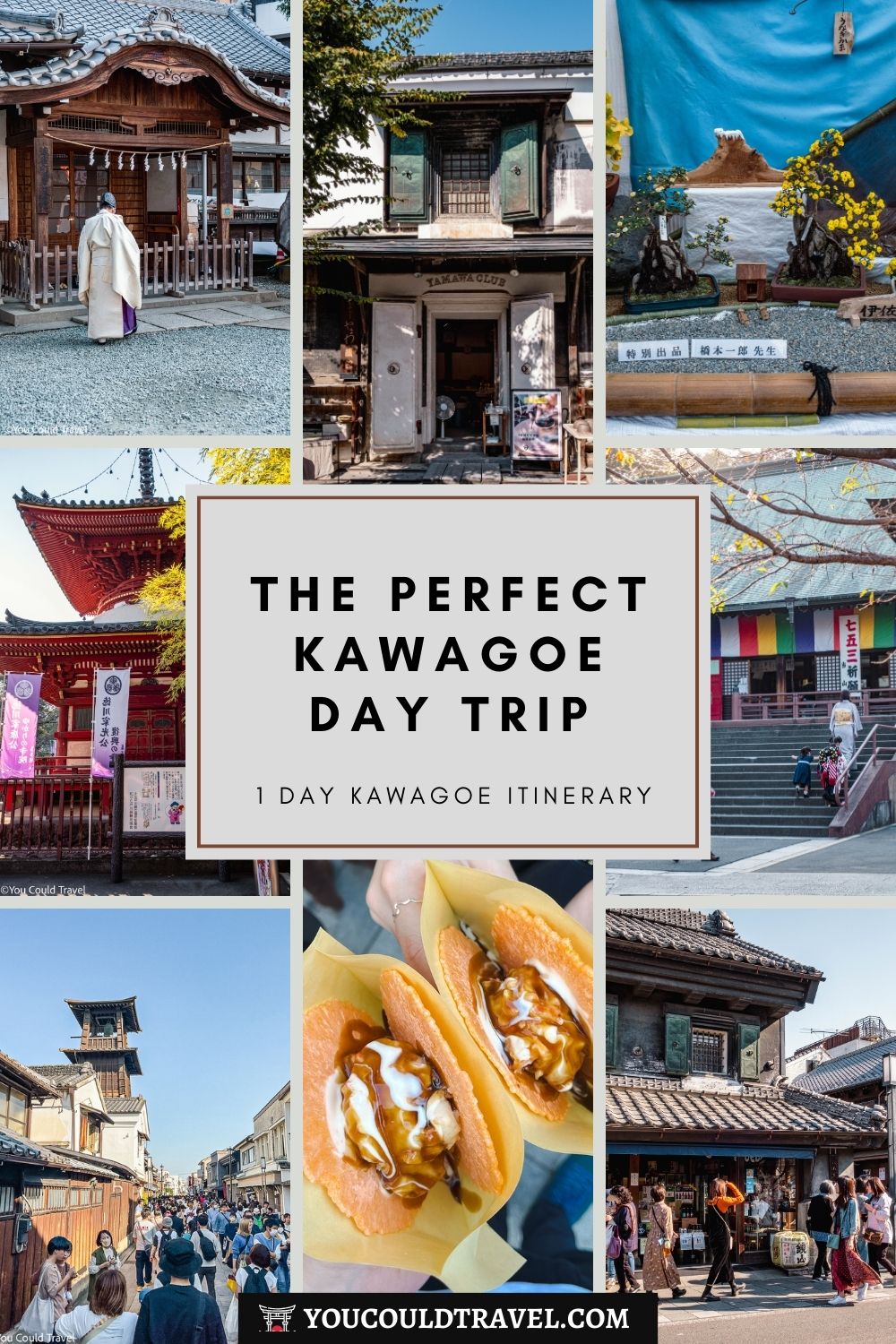


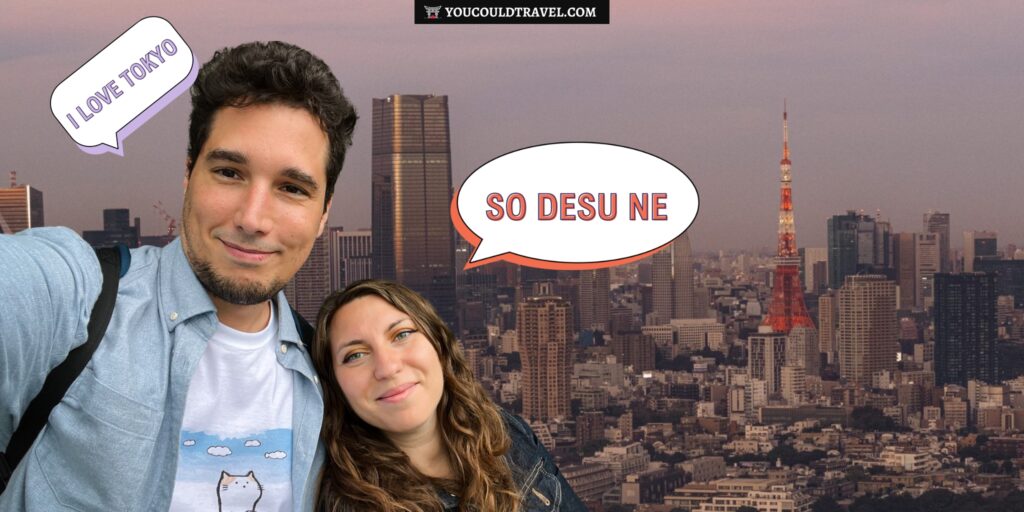
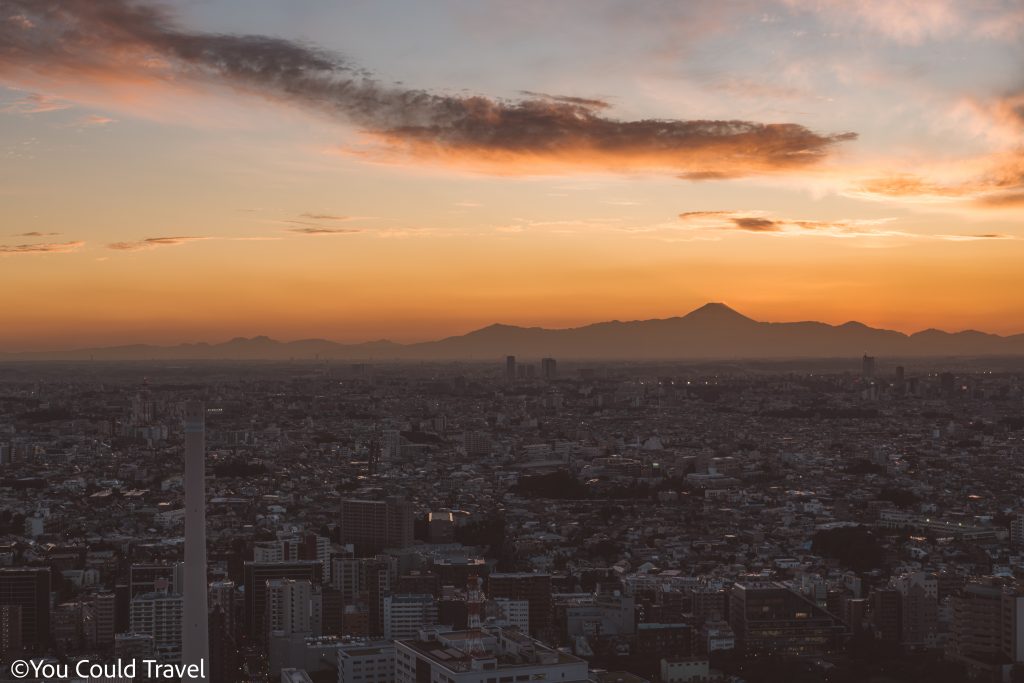
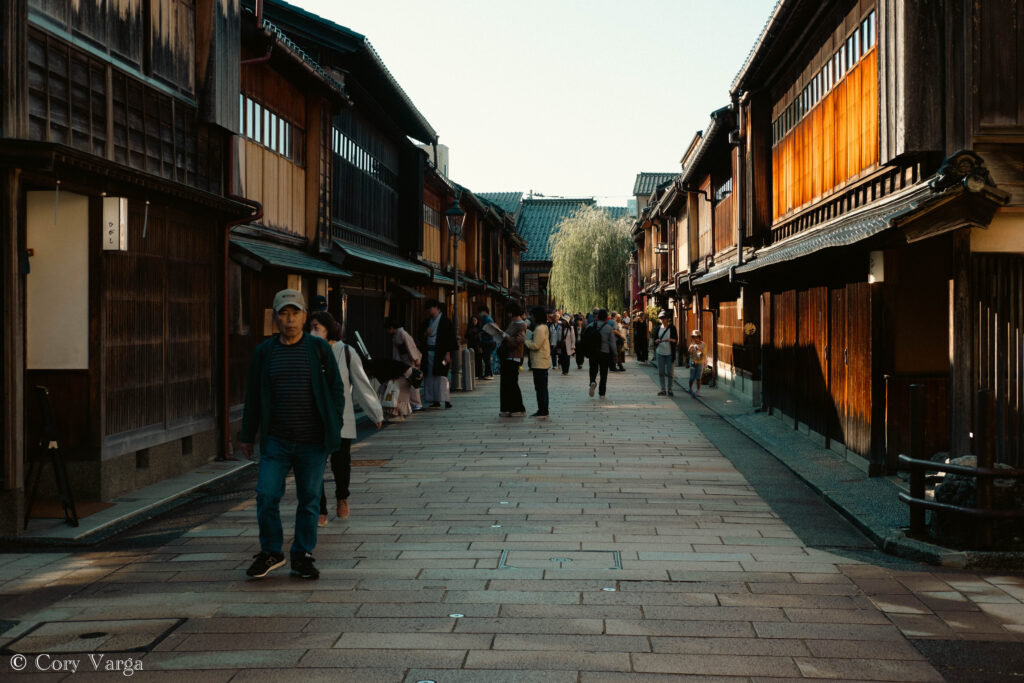
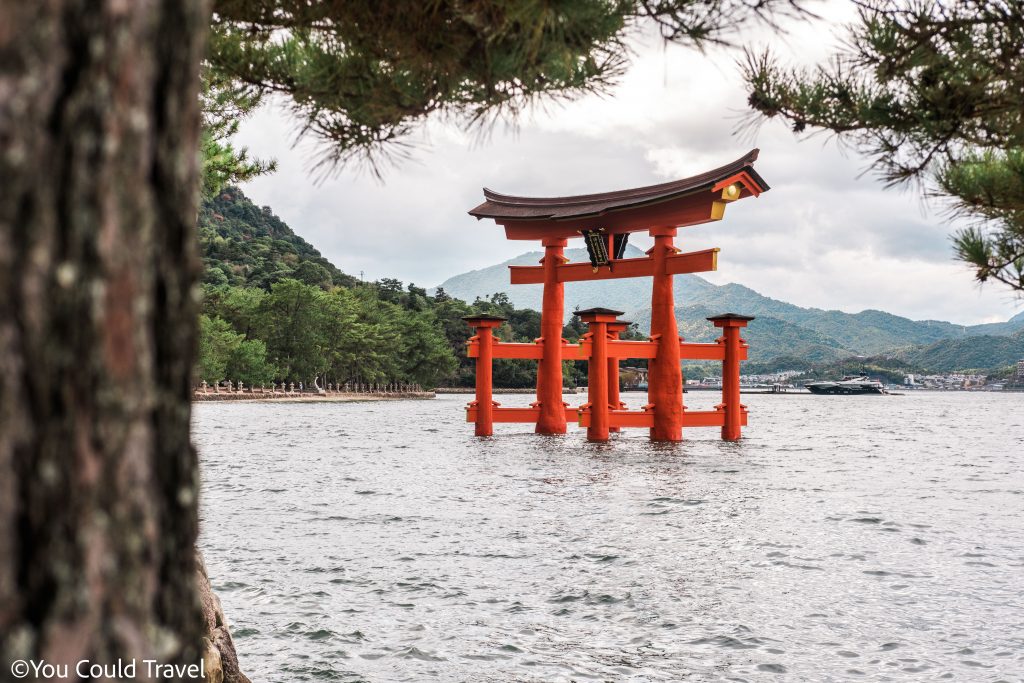
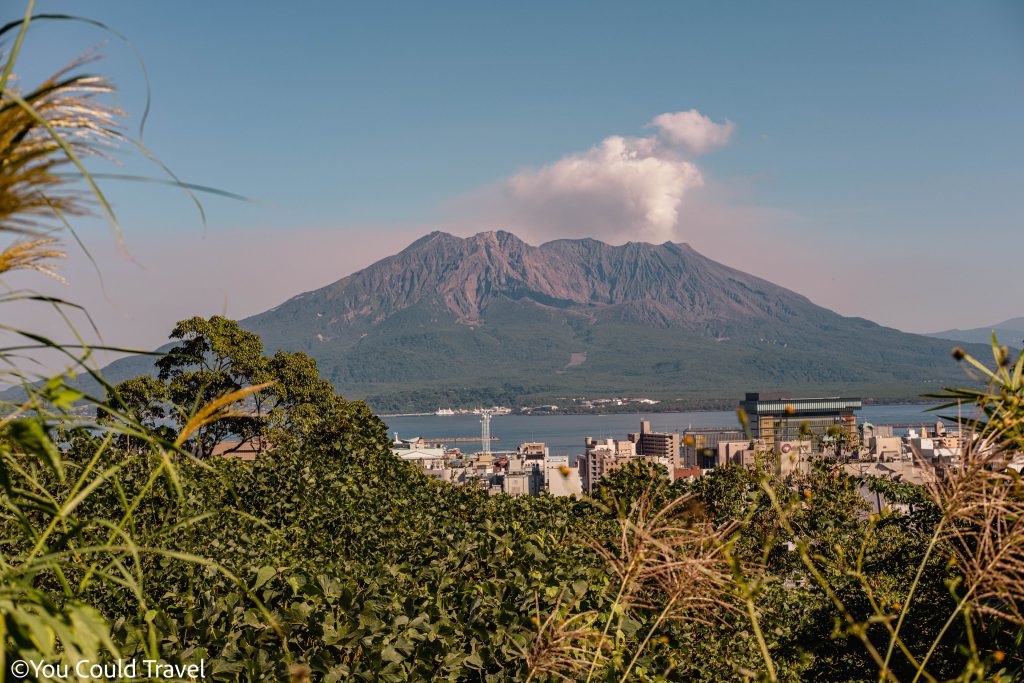


Leave a Reply